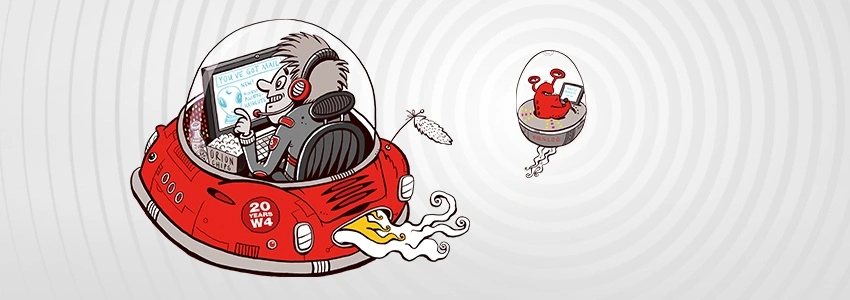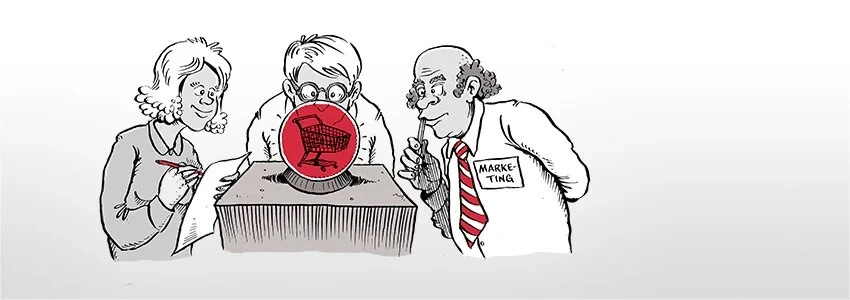The digitalization and interaction of consumers with brands has caused a change of demands in communication. Flexibility in messages and the visual appearance is needed to fulfill the expectations of all target groups as well as the media. A reasonable explanation comes from a close look at the recipient of brand communication: the consumer, who is supposed to establish an emotional relationship with companies and products.
Table of contents
- Digital brand communication
- The modern customer
- Brand messages become multidimensional
- Brands change to platforms
- The brand identity allows more flexibility
- Brand communication in the digital transformation
Digital brand communication
Modern buyers are no longer of the one-dimensional type: neither in their decisions at work nor in their private lives. In the wake of postmodernism, which caused individual life models, modern customers have defined their own value systems for each area of their lives and act accordingly, consciously or unconsciously.
Digital Brand Communication is the strategy of engaging with consumers through digital channels to build meaningful relationships. Unlike traditional one-way messaging, it’s dynamic, responsive, and tailored to individual values and preferences of a particular customer. In today’s market, consumers expect brands to be authentic and aligned with their beliefs. This approach allows companies to adapt messages in real-time, using platforms like social media and content marketing to create an interactive, personalized experience. For businesses, digital brand communication is key to fostering loyalty and building emotional connections with customers, and standing out in a competitive landscape.
.webp?width=727&height=414&name=worldofme_EN%20(1).webp)
The modern customer
The world of me customer is curious. He is constantly online in order not to miss any trend which influencer, friends from his environment or the brands of his trust have tracked down or occupy.
The world of me customer is social. He makes a claim to individuality. He wants to act within an appropriate "community" and find confirmation and further inspiration. Likes and followers are important instruments of self-affirmation and identification in the online community.
The world of me customer is creative. The high reputation of start-ups, the democratization of the Internet with YouTube stars and the beautiful lives of self-made influencers have shown that everyone can be actively creative and impress others with a targeted mixture of their own ideas and their interpretation of lifestyle. He transfers this external image to himself.
The world of me customer lives a healthy life. Whether fitness, cosmetics, clothing or nutrition: values resonate in almost every purchase decision and are linked in a modified form to environmental friendliness, for example when purchasing electronics (conservation of resources).
The world of me customer wants to be treated as a VIP. Flying in Business Class at the same price, being on the guest list while others have to pay or receiving the limited promotional package with two extra features at the same price – many people appreciate receiving better or more exclusive services than others.
The world of me customer is busy. If it is possible to save time on products or shopping, the overall feeling is a positive one. Whether this is possible via personalized offers in the online shop or special delivery times and set-up services – there are many possibilities.
The aforementioned characteristics represent a selection of the manifold identities. There are no limits. No matter how many identities a world of me consumer unites in himself, he always has three demands:
Wow me.
Know me.
Socialize me.
Download our FREE whitepaper for further information on the World of me identities of consumers.
Brand messages become multidimensional
The diverse identities united within the consumer imply that brands have to process their promises multidimensionally in order to build up loyal groups of buyers. Let's start here with a comparison with the previous years when messages were mainly spread in print advertising, television commercials and advertisements. It was enough to create a brand with simple, one-dimensional brand promises with high penetration and consistency. The messages were closely linked to the essential added value of the product or service, such as "wonderfully soft linen" for fabric softeners or "Volkswagen – the car". Today, more is needed to touch relevant groups of buyers emotionally. Brand loyalty arises when the messages are formulated multidimensionally and, in addition to the classic reference to the functionalities and properties of the product, possible further promises are made. These can be messages about short delivery times or product features that can be flexibly arranged.
Through its communication, the brand positions itself as a utility brand with a high benefit promise or as an experience brand that creates a bond through the experience with the product.
The brand promise for the world of me customer

Brands change to platforms
Brand platforms open up a number of opportunities for companies to play out multidimensional promises to consumers. The relevant identities of World of me customers can be actively addressed on the basis of content and stories specially prepared along the identities and relating to the characteristics, impact and use of the brand's products. Brands occupy strategically important search phrases on the platform and make them available to the search engine for consumer queries. The fact that important keywords and phrases are filled from the continuous display of content represents the great advantage of brand platforms for search engines. Overall, the digital brand has to limit itself less in its communication style than in the print sector. It is also easier to testing with smaller campaigns.
The brand identity allows more flexibility
Given the number of online platforms and social media channels such as Instagram and Facebook, can there still be a one-hundred-percent uniform brand identity? Certainly not. As with messages, it is also worth adapting the visual appearance flexibly to the typical patterns of digital channels. The time of great symbolism is over. Campaigns for brand awareness are shorter and convey flexible messages that are more oriented to trends, consumer preferences and correspond to the look and feel of the respective target media. The image of a brand becomes a projection screen for everyone's self-portrayal. This applies to the way in which content is prepared as text, image and video as well as to the design. What remains of a brand's recognition value? The question as to how far one can distance oneself from one's corporate design in order to preserve one's identity must be answered on a highly individual level.
Brand communication in the digital transformation
In the W4 white paper "Brand communication in the digital transformation" you can read in detail how companies secure clicks from search queries and gain loyalty through targeted, multidimensional brand messages and storytelling on their own platforms.




.webp)





